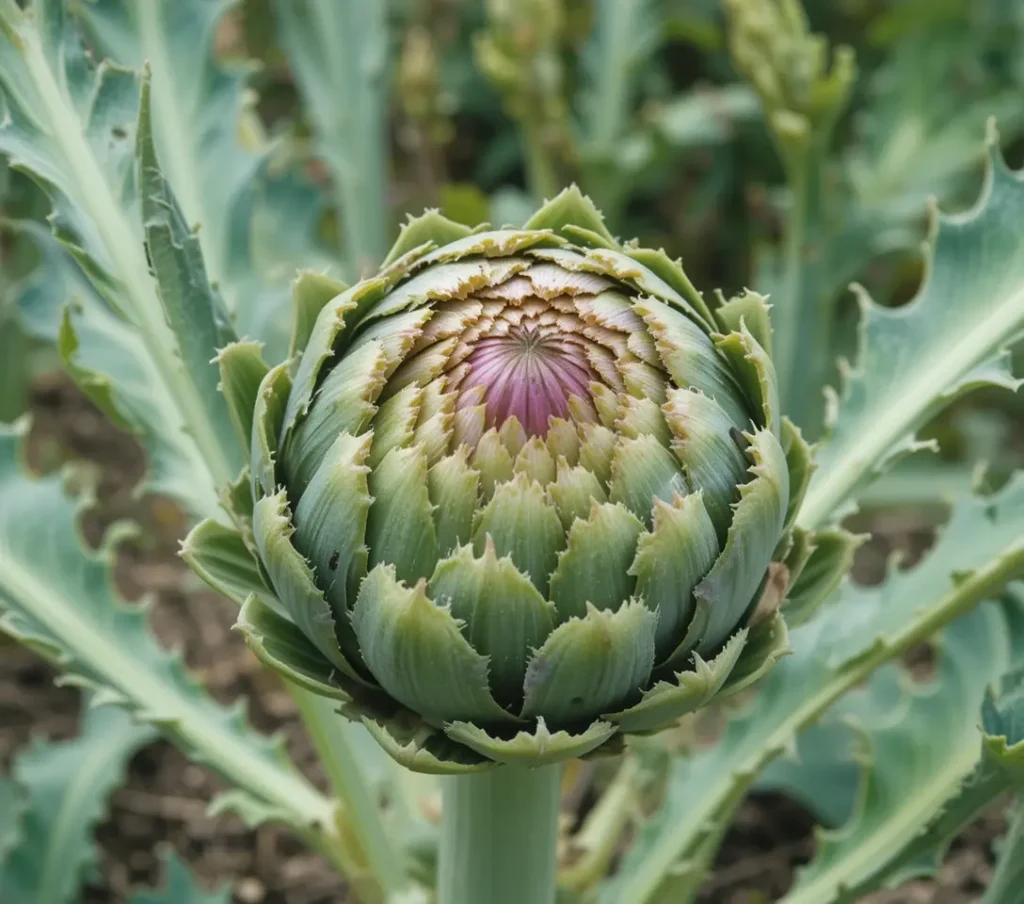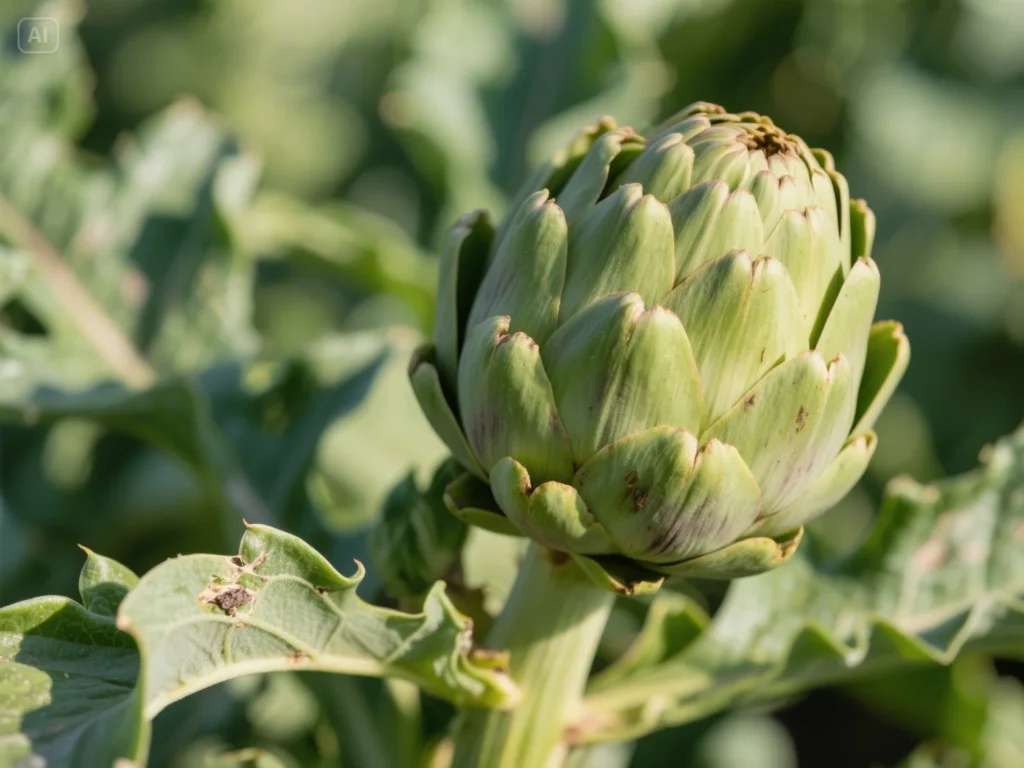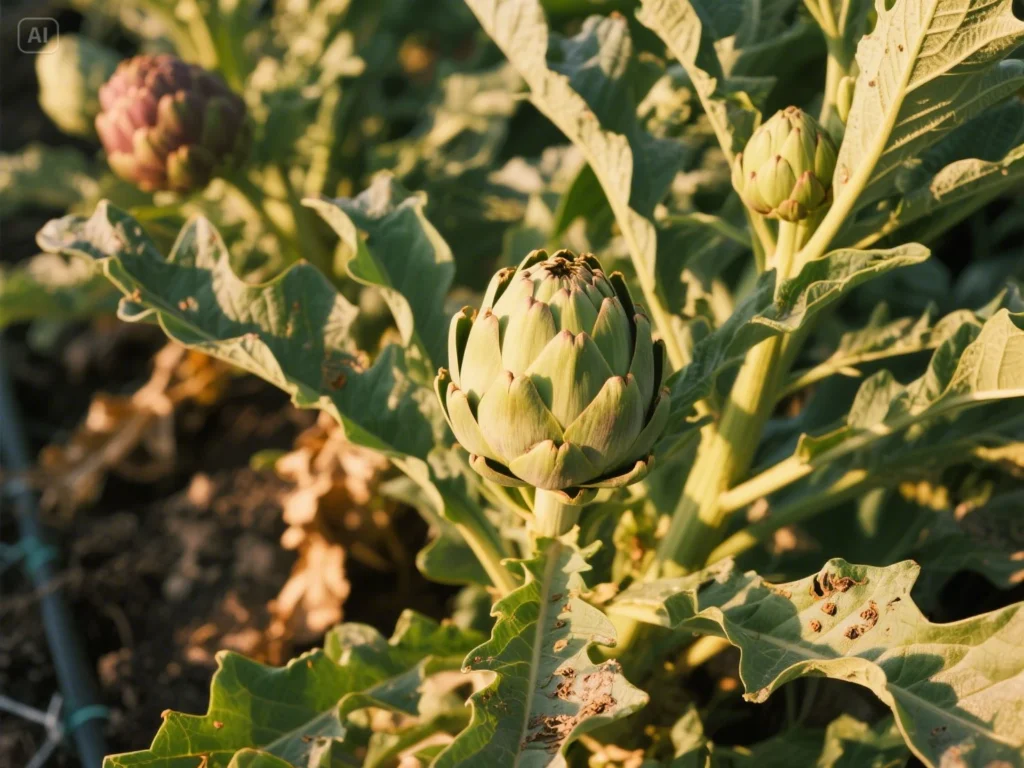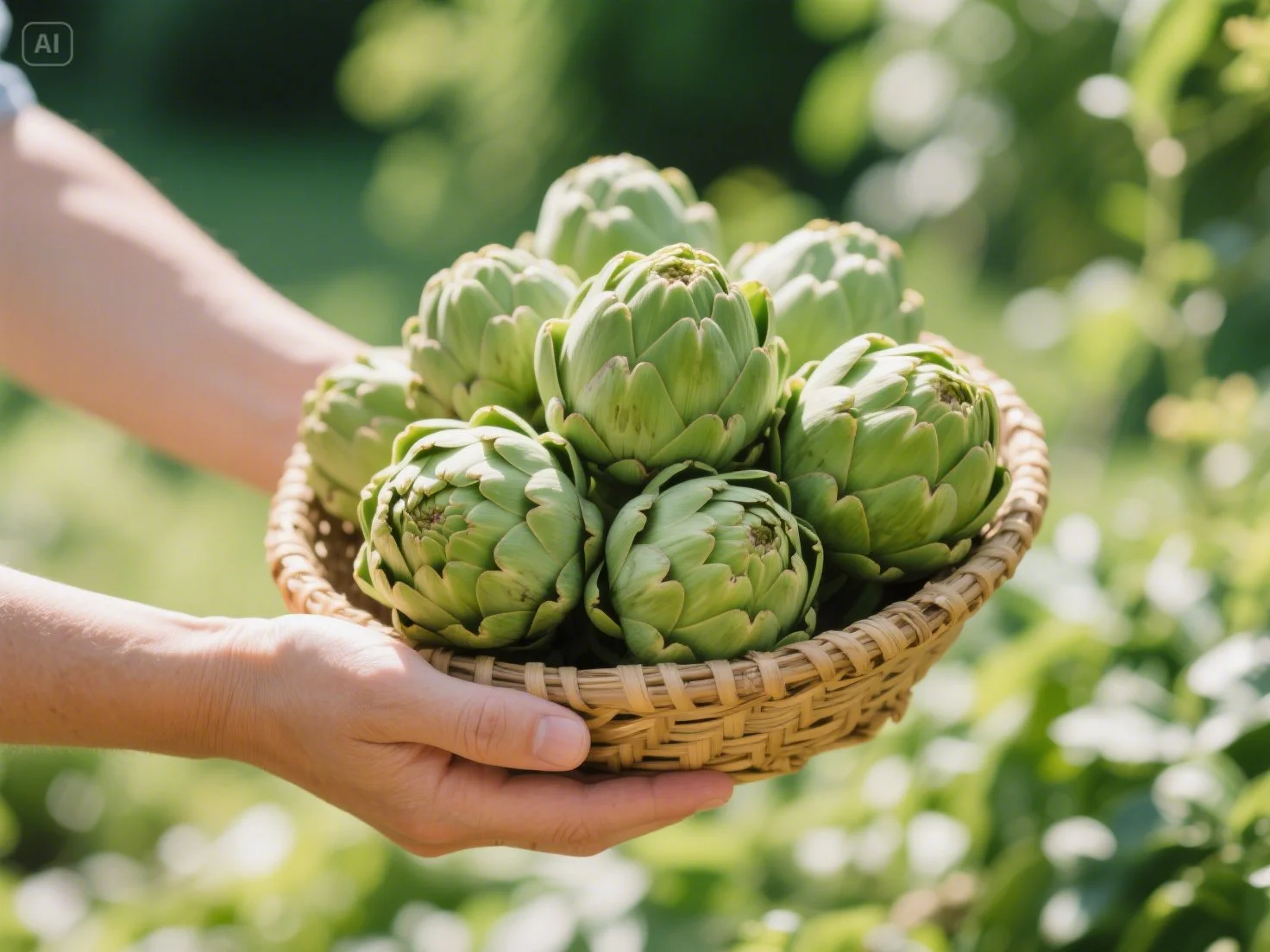Introduction
Imagine a plant serving gourmet meals and turning heads in your garden. Meet the artichoke plant, a striking perennial with silvery-green leaves, towering flower stalks, and edible buds prized in kitchens worldwide. A member of the thistle family (Cynara cardunculus), this Mediterranean native thrives in sunny spots, offering both beauty and bounty. While its juicy flower buds steal the spotlight in dishes like dips and salads, the plant itself adds drama to landscapes with its bold, architectural form.
But the artichoke isn’t just for foodies. Gardeners love it for its low-maintenance nature and versatility. Whether you’re growing it as a perennial vegetable in warm climates or an annual ornamental in cooler zones, it rewards patience with a harvest that’s as impressive on the plate as it is in the garden.
This guide will walk you through every step, from planting your first artichoke to harvesting plump buds and troubleshooting common issues. You’ll also discover lesser-known varieties, clever uses beyond cooking, and tips to make this plant thrive in your unique growing conditions. Let’s dig into why the artichoke deserves a prime spot in your garden (and your kitchen).
Key Features:
- Dual-purpose plant: Edible buds + ornamental appeal.
- Adaptable: Grows as a perennial (zones 7–11) or annual.
- Low effort, high reward: Minimal care for years of harvests.
Why This Guide?
We’ve packed it with tested strategies, clear visuals, and answers to questions even experienced growers ask. There is no fluff, just actionable steps to grow artichokes successfully, whether you’re a rookie or a seasoned green thumb.
What Exactly Is an Artichoke Plant?

The artichoke plant (Cynara cardunculus var. scolymus) is a perennial vegetable known for its edible flower buds and striking appearance. Native to the Mediterranean, it thrives as a perennial in USDA hardiness zones 7–11, where winters stay mild. In colder regions (zones 6 and below), it’s often grown as an annual, replanted each spring.
A Member of the Thistle Family (Asteraceae)
The artichoke belongs to the Asteraceae family, sharing lineage with thistles and cardoons. This heritage explains its bold, spiky leaves and towering flower stalks that can reach 4–6 feet tall. Like its wild relatives, the plant produces a large, thistle-like flower if left unharvested, though gardeners typically pick the buds before they bloom.
Edible Flower Bud: The “Artichoke Heart” and Choke
The part we eat is the immature flower bud, harvested before it opens. Here’s what’s inside:
- Edible parts:
- Heart: The tender base of the bud, prized for its rich, nutty flavor.
- Fleshy leaf bases: The meaty lower portions of the bud’s outer scales.
- Inedible parts:
- Choke: The fuzzy, fibrous center that forms as the bud matures. Remove it before cooking!
Pro tip: Harvest buds when they’re tight and firm. Once the choke turns hairy and the scales loosen, the bud is past its prime.
Perennial vs. Annual Growth Habits
- Perennial in warm climates (zones 7–11):
- Plants survive winter dormancy and produce buds for 3–5 years.
- Require a chilling period (vernalization) to trigger bud formation.
- Annual in cold climates (zones 6 and below):
- Grown from seed or transplants each spring.
- May not flower if winters lack consistent cold snaps.
Why vernalization matters: Artichokes need 10–14 days of temperatures below 50°F (10°C) to shift energy from leaves to bud production. Without this chill, plants might focus on foliage instead of harvestable buds.
Key Takeaway:
- Warm climates = multi-year harvests.
- Cold climates = plant annually and prioritize early-season chilling.
- Always harvest buds before the choke toughens.
This blend of rugged beauty and kitchen-ready yields makes the artichoke plant a standout in gardens and on plates. Next, we’ll break down how to plant and nurture your own.
Getting Started: Planting Your Artichokes

Planting artichokes begins with timing and method. These plants grow best when started in early spring or fall (in mild climates). Choose between seeds for flexibility or transplants for quicker results. We’ll break down both options below.
Choosing the Right Location: Sun and Soil
Artichokes demand two non-negotiables:
- Full sun: At least 6–8 hours of direct sunlight daily. Less light means smaller buds and weaker plants.
- Well-draining soil: Soggy roots invite rot. Amend heavy clay soils with compost or aged manure to boost drainage and fertility.
- Ideal pH: Slightly acidic to neutral (6.5–7.5). Test your soil with a $10 kit from garden centers and adjust with lime (to raise pH) or sulfur (to lower it).
Starting from Seeds vs. Crowns/Transplants
Seeds
- Pros: Affordable, wide variety of choices.
- Cons: Slower—requires patience.
- Start indoors 8–12 weeks before your last frost.
- Chill seeds in the fridge for 1–2 weeks before sowing to mimic winter (improves germination).
- Transplant seedlings outdoors after frost risk passes.
Crowns/Transplants
- Pros: Harvest buds 1 year faster.
- Cons: Higher upfront cost.
- Plant root divisions or nursery-bought starts in spring.
- Ideal for gardeners in colder zones (harvest buds the first year).
Spacing Your Artichoke Plants
Give these giants room to sprawl:
- Space plants 4–6 feet apart in all directions. Mature artichokes reach 3–4 feet tall and wide.
- For rows, leave 5–6 feet between them to allow walking and tool access.
- Tight spacing? Expect smaller buds and higher disease risk from poor airflow.
Pro tip: In small gardens, grow one artichoke plant in a 20-gallon container with drainage holes. Use a mix of potting soil and compost.
Key Takeaway:
- Full sun + compost-rich soil = happy plants.
- Seeds suit patient growers; crowns deliver faster yields.
- Crowding stifles growth; prioritize space for robust harvests.
Up next: How to care for your artichokes to ensure they thrive year after year.
Essential Artichoke Plant Care for a Bountiful Harvest

Artichokes thrive with consistent care during the growing season. Here’s how to keep them healthy and productive:
Watering Needs: Consistent Moisture
- Deep watering: Provide 1–2 inches of water weekly, soaking the soil 12–18 inches deep. Use a soaker hose to avoid wetting leaves.
- Bud formation boost: Increase watering slightly as buds develop to prevent a tough, woody texture.
- Avoid soggy soil: Let the top inch of soil dry between waterings. Yellow leaves or wilting can signal overwatering.
Feeding Your Hungry Artichoke Plants
- Balanced fertilizer: Apply a 10-10-10 NPK formula in early spring and again when buds form.
- Organic options: Side-dress with compost or aged manure every 6–8 weeks. For a quick nutrient boost, try compost tea.
- Caution: Excess nitrogen leads to leafy growth, not buds. Stick to the schedule!
Mulching Benefits
- Retain moisture: Spread 2–3 inches of straw, shredded leaves, or compost around plants (keep mulch 3 inches from the crown).
- Weed control: Blocks weeds that compete for nutrients.
- Temperature regulation: Insulates roots from summer heat and winter chills.
Overwintering Artichokes in Colder Climates (Zones 6 and Below)
- After first frost: Cut stems to 6–8 inches tall.
- Insulate the crown: Pile 12 inches of straw or leaves over the base.
- Cover with burlap: Secure with stakes to protect from wind and ice.
- Container plants: Move pots to a garage or shed; water lightly once a month.
Artichoke Companion Planting Ideas
- Good companions:
- Peas: Fix nitrogen in the soil.
- Cabbage family: Artichokes deter cabbage worms.
- Tarragon: Enhances flavor and growth.
- Avoid: Potatoes, tomatoes (shared pests like aphids).
Pro Tips:
- Check soil moisture with a finger test before watering.
- Refresh mulch in late spring and fall.
- In zones 6–7, use row covers for extra winter protection.
With these steps, your artichokes will reward you with tender buds and lush foliage. Next, explore the best varieties to match your garden!
Popular Artichoke Varieties to Grow
Artichokes aren’t one-size-fits-all. From classic green globes to vibrant purple types, each variety offers unique flavors, shapes, and growing perks. Let’s explore the top picks for home gardens.
Green Globe Artichoke
A timeless favorite, Green Globe is reliable and adaptable.
- Appearance: Round, 3–5 inch buds with tightly packed green scales.
- Flavor: Nutty, tender hearts are perfect for steaming or grilling.
- Growth: Perennial in zones 7–11; cold-hardy down to 20°F (-6°C).
- Yield: Produces 6–12 buds per plant annually.
Best for: Gardeners in mild climates wanting a steady, long-term harvest.
Purple of Romagna (Violetto)
This Italian heirloom adds drama to gardens and plates.
- Appearance: Elongated, 4–6 inch buds with deep purple streaks.
- Flavor: Slightly sweeter and milder than Green Globe.
- Growth: Perennial in zones 7–10; stunning magenta flowers if left to bloom.
Best for: Those prioritizing beauty and gourmet flavor.
Imperial Star
Ideal for short growing seasons or annual planting.
- Appearance: Compact plants with 3–4 inch green buds.
- Flavor: Mild, with a buttery texture.
- Growth: No vernalization needed—harvest buds the first year.
Best for: Cold-climate gardeners (zones 4–6) or container growing.
Other Notable Varieties
- Emerald: Cold-tolerant, with spineless leaves for easy handling.
- Big Heart: Giant, thornless buds (up to 6 inches) for stuffing.
- Tempo: Early-maturing hybrid, great for humid climates.
Key Takeaway:
- Warm zones? Stick with Green Globe or Violetto for multi-year yields.
- Cold zones? Choose Imperial Star or Emerald for quick results.
- Small space? Compact Tempo thrives in pots.
With the right variety, you’ll enjoy artichokes tailored to your climate and kitchen. Next, learn when and how to harvest them at peak perfection!
The Rewarding Art of Harvesting Artichokes
Harvesting artichokes at the right moment ensures tender, flavorful buds. Here’s how to pick them like a pro:
When Are Artichoke Buds Ready?
- Size: Buds reach 3–5 inches wide (varies by variety).
- Texture: Scales (bracts) are tightly closed and firm.
- Color: Bright green or purple (depending on type), without dry tips.
Act fast: Once scales loosen or show a purple tinge at the tips, the bud is overripe.
How to Cut the Chokes
- Use sharp pruners or a knife to avoid crushing the stem.
- Cut the stem 1–3 inches below the bud base.
- Leave 2–3 inches of stem attached to the plant to encourage side shoots.
Pro tip: Wear gloves, artichoke stems have tiny spines!
Primary vs. Secondary Buds
- Primary bud: The large, central bud forms first. Harvest it when it’s plump.
- Secondary buds: Smaller buds grow on side shoots after the main harvest. Pick these when they reach 2–3 inches wide.
Maximize yields: Check plants every 3–4 days during peak season.
What Happens if You Don’t Harvest? The Artichoke Flower
If left unharvested, buds bloom into striking purple thistle-like flowers.
- Pollinator magnet: Bees and hummingbirds flock to the vibrant blooms.
- Downside: The bud becomes tough and inedible once flowering starts.
Best of both worlds: Let one bud per plant bloom for pollinators, and harvest the rest.
Key Takeaway:
- Harvest buds when tight and firm for the best flavor.
- Cut stems cleanly to avoid plant damage.
- Balance your harvest: Feed your kitchen and local pollinators.
Mastering the timing transforms your garden into a gourmet resource. Up next: Troubleshooting common artichoke challenges.
Troubleshooting Common Artichoke Problems
Even hardy artichokes face challenges. Here’s how to spot and fix issues before they derail your harvest.
Dealing with Artichoke Pests
Aphids
- Signs: Clusters of tiny green/black bugs on stems and buds; sticky residue (honeydew).
- Fix:
- Spray with insecticidal soap or neem oil (apply in the evening to avoid sun damage).
- Introduce ladybugs or lacewings to eat aphids naturally.
Slugs & Snails
- Signs: Irregular holes in leaves; silvery trails.
- Fix:
- Set beer traps or sprinkle diatomaceous earth around plants.
- Use copper tape barriers to deter them.
Artichoke Plume Moth
- Signs: Brown tunnels in stems; wilted leaves.
- Note: Common in coastal areas. Check with local extension services for regional advice.
Common Artichoke Diseases
Powdery Mildew
- Signs: White, powdery spots on leaves.
- Fix:
- Improve airflow by spacing plants properly.
- Apply sulfur-based fungicide at the first signs.
Root Rot / Crown Rot
- Signs: Yellow leaves, mushy stems, stunted growth.
- Prevent:
- Plant in well-draining soil (add sand or perlite if needed).
- Avoid overwatering; let the soil dry slightly between waterings.
Botrytis Blight (Gray Mold)
- Signs: Gray fuzzy mold on buds or stems.
- Fix: Remove infected parts; avoid overhead watering.
Why Isn’t My Artichoke Plant Producing Buds?
Insufficient Chilling
- Fix: Ensure plants get 10–14 days below 50°F (10°C). In warm climates, refrigerate transplants before planting.
Lack of Sun
- Fix: Move to a spot with 6–8 hours of direct sunlight.
Poor Nutrition
- Fix: Test the soil and apply balanced fertilizer (higher phosphorus for bud growth).
Plant Age
- Fix: Young plants may take 1–2 years to bud. Replace plants older than 5 years.
Environmental Stress
- Fix: Shield plants from extreme heat/cold; control pests promptly.
Pro Tips:
- Prevent pests: Grow marigolds or nasturtiums nearby to repel aphids.
- Boost immunity: Water with compost tea monthly to strengthen plants.
- Stay vigilant: Inspect plants weekly for early signs of trouble.
With these solutions, you’ll keep your artichokes thriving. Next up: Surprising uses for this versatile plant beyond the kitchen!
Beyond the Plate: Other Uses and Benefits of the Artichoke Plant
The artichoke plant offers more than just tasty buds. Discover how to leverage its beauty, health perks, and ecological benefits in your garden.
Ornamental Value in the Edible Landscape
Artichokes double as striking garden decor:
- Bold foliage: Silvery-green, deeply lobed leaves add texture and contrast.
- Architectural height: Flower stalks tower 4–6 feet, creating vertical interest.
- Design tip: Plant alongside lavender, rosemary, or ornamental grasses for a Mediterranean vibe.
Pro tip: Use young artichoke plants in patio pots for a portable statement piece.
Potential Health Benefits
While not a substitute for medical advice, artichokes have been studied for their:
- Liver support: Compounds like cynarin and silymarin may aid detoxification.
- Digestive aid: High fiber content promotes gut health.
- Antioxidants: Buds and leaves contain flavonoids linked to heart health.
Note: Always consult a healthcare provider before using plants medicinally.
Attracting Pollinators (If Flowers Allowed)
Letting a few buds bloom pays off for local wildlife:
- Bees: Drawn to the nectar-rich purple flowers.
- Hummingbirds: Frequent visitors attracted to vibrant colors.
- Trade-off: Once flowers open, buds become too tough to eat.
Balance: Harvest 90% of buds for your kitchen; leave 10% for pollinators.
Key Takeaway:
- Garden beauty: Artichokes add drama to borders and containers.
- Wellness potential: Buds and leaves offer nutrients and antioxidants.
- Eco-friendly choice: Flowers support biodiversity in your yard.
This multi-talented plant proves that growing artichokes is about more than a meal; it’s about nurturing a garden ecosystem. Next, meet its lesser-known cousin: the cartoon!
The artichoke has a lesser-known relative: the cardoon (Cynara cardunculus var. altilis). While they share a family tree, these plants serve different roles in the garden and kitchen.
Artichoke’s Cousin: Understanding the Cardoon
Similarities and Differences
Appearance:
- Artichoke: Prized for its edible flower buds, with silvery-green leaves and a compact, bushy form (3–4 feet tall).
- Cardoon: Grown for its celery-like stalks, featuring taller growth (5–6 feet) and deeply serrated, silver-gray leaves.
Growth habits:
- Both thrive in full sun and well-draining soil, preferring Mediterranean-like climates.
- Cardoon tolerates slightly cooler temperatures (zones 6–10 vs. artichoke’s 7–11).
Edible Parts (Stalks vs. Flower Buds)
- Artichoke: Harvest flower buds before they bloom. The heart and fleshy leaf bases are edible.
- Cardoon: Eat the blanched leaf stalks, which taste like a mix of celery and artichoke.
- Prep work: Wrap stalks in burlap or cardboard 3–4 weeks before harvest to tenderize them.
Note: Cardoon flowers resemble artichoke blooms but are rarely eaten.
Key Takeaway:
- Grow artichokes for plump buds and ornamental appeal.
- Grow cardoon for hearty stalks in soups or gratins.
- Pro tip: Plant both for a striking, edible landscape with varied harvests.
While they look alike at a glance, artichokes and cardoons cater to different tastes and garden goals. Next, wrap up with final tips to grow both successfully!
Conclusion
Growing artichokes blends practicality with beauty. These plants reward gardeners with tender buds for the kitchen and striking foliage for the landscape. In warm climates (zones 7–11), they return yearly as reliable perennials, while colder zones can enjoy them as annuals or container stars. Whether you’re after gourmet harvests, pollinator-friendly blooms, or bold garden drama, the artichoke plant delivers.
Key Takeaways:
- Dual-purpose: Edible buds + ornamental appeal.
- Low effort: Basic care yields years of harvests.
- Adaptable: Thrives in gardens or pots.
Your Turn!
Have you grown artichokes before? Share your favorite variety or a tip that’s worked for you in the comments below! If this guide helped you, consider passing it along to a fellow gardener. Together, we can turn more backyards into artichoke havens.
Happy growing!
P.S. Bookmark this post for quick reference during planting season. Missed a section? Use the headings above to jump back to key tips.
This wraps up our deep dive into artichoke growing. Now, let’s tackle your top questions in the FAQs!
FAQs
Can I grow artichokes in containers?
Yes! Use a 20-gallon pot with drainage holes and well-draining soil. Compact varieties like Imperial Star work best.
How long does it take to harvest artichokes?
Seeds: 120–150 days.
Crowns/transplants: 85–100 days.
Do artichokes come back every year?
Only in zones 7–11. In colder zones, treat them as annuals or overwinter plants indoors.
What pests attack artichokes?
Aphids: Spray with soapy water.
Slugs: Use diatomaceous earth or beer traps.
How do I know when to harvest?
Pick buds when 3–5 inches wide, with tight, closed scales. Avoid loose or flowering buds.
Can I eat the leaves of an artichoke plant?
Only the tender inner leaves (near the bud) are edible. Outer leaves are too fibrous.
Why isn’t my artichoke producing buds?
Common causes:
Insufficient chilling (below 50°F).
Too much shade.
Over-fertilizing with nitrogen.
What’s the difference between artichokes and cardoons?
Artichokes: Grown for flower buds.
Cardoons: Grown for edible, blanched stalks.
How do I overwinter artichokes in cold climates?
1. Cut stems to 6 inches after frost.
2. Cover crowns with 12 inches of straw.
3. Wrap in burlap for extra insulation.
Are artichoke flowers edible?
No once the bud opens into a purple flower, it’s too tough to eat. Let it bloom for pollinators instead!
Have more questions? Drop them in the comments!
